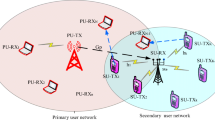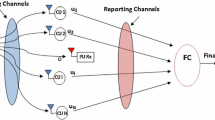Abstract
Cognitive Radio (CR) is an essential technique for the future generation green communication paradigm owing to its inherent advantages of adaptability and cognition. The compulsory spectrum sensing is a critical component to facilitate systems co-existence. In this paper, we propose a new Time-Division Energy Efficient (TDEE) sensing scheme in which the sensing period is divided into an optimal number of timeslots and each Secondary User (SU) is assigned to detect a different channel in one time-slot. An important advantage of TDEE is that the SUs do not need to exchange the control messages for the acknowledgement of a successful cooperation, leading to substantial energy saving without compromising sensing accuracy. Both homogeneous and heterogeneous networks are investigated with respect to the intrinsic trade-off between spectrum efficiency and energy-efficiency. Illustrative results demonstrate that the proposed TDEE is able to achieve much lower energy consumption and higher throughput, compared to the existing mechanisms.










Similar content being viewed by others
References
FCC (2002) Spectrum Policy Task Force, Rep. ET Docket no. 02-135
Haykin S (2005) Cognitive radio: brain-empowered wireless communications. IEEE J Sel Areas Commun 23(2):201–220
Jovičić A, Viswanath P (2009) Cognitive radio: an information-theoretic perspective. IEEE Trans Inf Theory 55(9):3945–3958
Ghasemi A, Sousa ES (2008) Spectrum sensing in cognitive radio networks: requirements, challenges and design trade-offs. IEEE Commun Mag 46(4):32–39
Lee W-Y, Akyildiz IF (2008) Optimal spectrum sensing framework for cognitive radio networks. IEEE Trans Wirel Commun 7(10):3845–3857
Zhao Q, Tong L, Swami A, Chen Y (2007) Decentralized cognitive MAC for opportunistic spectrum access in ad hoc network: a POMDP framework. IEEE J Sel Areas Commun 25(3):589–600
Jia J, Zhang Q, Shen X (2008) HC-MAC: a hardware-constrained cognitive MAC for efficient spectrum management. IEEE J Sel Areas Commun 26(1):106–117
Shen J, Liu S, Zeng L, Xie G, Gao J, Liu Y (2009) Optimisation of cooperative spectrum sensing in cognitive radio network. IET Communications 3(7):1170–1178
Liu Y, Yu R, Zhang Y, Xie S (2010) A group-based cooperative medium access control protocol for cognitive radio networks. In: proc. IWQOS, pp 1–9
Xie S, Liu Y, Zhang Y, Yu R (2010) A parallel cooperative spectrum sensing in cognitive radio networks. IEEE Trans Veh Technol 59(8):4079–4092
Pham HN, Zhang Y, Engelstad PE, Skeie T, Eliassen F (2010) Energy minimization approach for optimal cooperative spectrum sensing in sensor-aided cognitive radio networks. In: proc. IEEE WICON, pp 1–9
Lee C-h, Wolf W (2008) Energy efficient techniques for cooperative spectrum sensing in cognitive radios. In: proc. IEEE CCNC, pp 968–972
Feeney LM, Nilsson M (2001) Investigating the energy consumption of a wireless network interface in an ad hoc networking environment. In: proc. IEEE INFOCOM
Quan Z, Cui S, Sayed AH (2009) Optimal multiband joint detection for spectrum sensing in cognitive radio networks. IEEE Trans Signal Process 57(3):1128–1140
Su H, Zhang X (2008) Cross-layer based opportunistic MAC protocols for QoS provisionings over cognitive radio wireless networks. IEEE J Sel Areas Commun 26(1):118–129
Cordeiro C, Challapali K, Birru D, Sai Shankar N (2005) IEEE 802.22: the first worldwide wireless standard based on cognitive radios. In: proc. IEEE DYSPAN, pp 328–337
Xiang J, Zhang Y, Skeie T (2010) Medium access control protocols in cognitive radio networks. Wiley Wirel Commun Mob Comput (WCMC) 10(1):31–49
Yu R, Zhang Y, Huang M, Xie S (2010) Cross-layer optimized call admission control in cognitive radio networks. ACM/Springer Mob Netw Appl (MONET) 15(5):610–626
Acknowledgements
The work in this paper is partially supported by programs of NSFC under Grant nos.60903170, U0835003, U1035001; the Specialized Research Fund for the Doctoral Program of Higher Education (SRFDP, no. 20090172120010); the Fundamental Research Funds for the Central Universities, SCUT (no. 2009ZM0250); the Foundation for Distinguished Young Talents in Higher Education of Guangdong, China; the projects 208739/E20 and 205048/V11 funded by the Research Council of Norway.
Author information
Authors and Affiliations
Corresponding author
Rights and permissions
About this article
Cite this article
Liu, Y., Xie, S., Zhang, Y. et al. Energy-Efficient Spectrum Discovery for Cognitive Radio Green Networks. Mobile Netw Appl 17, 64–74 (2012). https://doi.org/10.1007/s11036-011-0307-5
Published:
Issue Date:
DOI: https://doi.org/10.1007/s11036-011-0307-5




